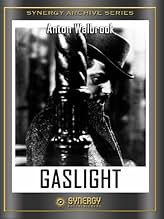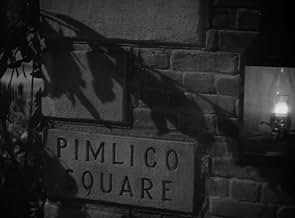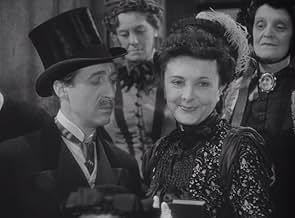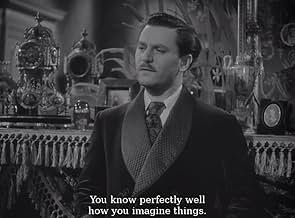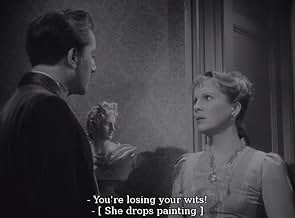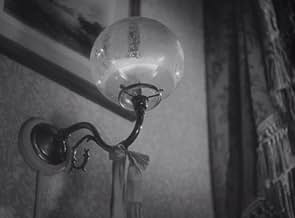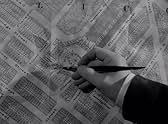IMDb RATING
7.3/10
5.7K
YOUR RATING
Twenty years after the murder of Alice Barlow, her house is finally occupied again. However, the husband from the couple who has moved in has a secret that he will do anything to keep hidden... Read allTwenty years after the murder of Alice Barlow, her house is finally occupied again. However, the husband from the couple who has moved in has a secret that he will do anything to keep hidden.Twenty years after the murder of Alice Barlow, her house is finally occupied again. However, the husband from the couple who has moved in has a secret that he will do anything to keep hidden.
- Director
- Writers
- Stars
Alfred Atkins
- Bit Role
- (uncredited)
Edwin Ellis
- Bit Role
- (uncredited)
Kathleen Harrison
- Bit Role
- (uncredited)
Katie Johnson
- Alice Barlow's Maid
- (uncredited)
Molly Raynor
- Bit Role
- (uncredited)
- Director
- Writers
- All cast & crew
- Production, box office & more at IMDbPro
Featured reviews
It is inevitable that this 1940 film and the 1944 "remake" with Charles Boyer and Ingrid Bergman are going to be compared, and people will have different opinions as to which is the better version.
To me, both 'Gaslight' films are great in their own way, and this reviewer ranks them equally, yet with one or two things in things that are done better in the other. Like the 1944 film (the only real drawback to that film was the uneven performance of Joseph Cotton), there is very little wrong here. The secondary characters could have been better fleshed out, and while Richard Adinsell's music score is suitably ominous Bonislau Kaper's score for the later version has more atmosphere, subtlety and tension.
However, while not as glossy as the later film 'Gaslight' (1940) regardless is incredibly well-made. It's shot beautifully and menacingly, is hauntingly lit and has sets that are picturesque yet give off a great amount of dread while over-stating it. It's intelligently and suspensefully directed by then-famous-and-well-regarded, now-almost-forgotten (undeservedly) Thorald Dickinson.
The script is thought-provoking and tense, everything feels relevant to what's going on and nothing seemed padded. Tighter-paced and more theatrical somewhat, the story never creaks and is leaden with tension and suspense with nothing obvious that came over as unnecessary or clumsy.
Performances are great here and hardly inferior to those in the later film, despite being less familiar. Anton Walbrook, while not as subtle as Charles Boyer, is terrifying and a huge part as to why the film is as atmospheric as it is. Diana Wynward demonstrates Bella's vulnerability incredibly movingly with no histrionics and she's hardly dull either (though the character has more range and depth to her in the 1944 version).
Frank Petingell looks more comfortable than Joseph Cotton, his performance is more even (though Cotton was hardly bad), the character is better written and he is more believable as a police officer (where Cotton's performance particularly fell down on). Robert Newton is a strong presence in an early role, and Cathleen Cordell is a hoot as Nancy.
All in all, despite being in the shadow of the 1944 'Gaslight' in popularity the earlier 1940 film doesn't deserve to be, because it is every bit as great. 9/10 Bethany Cox
To me, both 'Gaslight' films are great in their own way, and this reviewer ranks them equally, yet with one or two things in things that are done better in the other. Like the 1944 film (the only real drawback to that film was the uneven performance of Joseph Cotton), there is very little wrong here. The secondary characters could have been better fleshed out, and while Richard Adinsell's music score is suitably ominous Bonislau Kaper's score for the later version has more atmosphere, subtlety and tension.
However, while not as glossy as the later film 'Gaslight' (1940) regardless is incredibly well-made. It's shot beautifully and menacingly, is hauntingly lit and has sets that are picturesque yet give off a great amount of dread while over-stating it. It's intelligently and suspensefully directed by then-famous-and-well-regarded, now-almost-forgotten (undeservedly) Thorald Dickinson.
The script is thought-provoking and tense, everything feels relevant to what's going on and nothing seemed padded. Tighter-paced and more theatrical somewhat, the story never creaks and is leaden with tension and suspense with nothing obvious that came over as unnecessary or clumsy.
Performances are great here and hardly inferior to those in the later film, despite being less familiar. Anton Walbrook, while not as subtle as Charles Boyer, is terrifying and a huge part as to why the film is as atmospheric as it is. Diana Wynward demonstrates Bella's vulnerability incredibly movingly with no histrionics and she's hardly dull either (though the character has more range and depth to her in the 1944 version).
Frank Petingell looks more comfortable than Joseph Cotton, his performance is more even (though Cotton was hardly bad), the character is better written and he is more believable as a police officer (where Cotton's performance particularly fell down on). Robert Newton is a strong presence in an early role, and Cathleen Cordell is a hoot as Nancy.
All in all, despite being in the shadow of the 1944 'Gaslight' in popularity the earlier 1940 film doesn't deserve to be, because it is every bit as great. 9/10 Bethany Cox
What a crisp, deeply rooted thriller Thorold Dickinson created. With vile creatures (Paul) and goofy policemen and maids, we are easily captured into the world of the Mallens. Diana Wynyard does a spectacular job as Bella, giving us the right amount of insecurity coupled with fear. She is the true victim of this film and Dickinson does not let us forget that. Wynyard is nearly overshadowed by my favorite character of the film, Paul Mallen, played with so much evil by Anton Walbrook. I have seen several films in my life, and I must say that Walbrook ranks among some of the most sinister villains of them all. He has no super powers, just the ability to manipulate Bella mentally, proving that he is stronger than her. He thrives on Bella's insecurities and makes them into his greatest form of punishment. These two working together really transformed this 40s thriller into something concrete and powerful. It is the dynamic between the two that kept me glued to my seat and continually asking for more.
Coupled with the superb acting is the creativeness of Dickinson and his writer A.R. Rowlinson. Together they set the mood with darkened corners and alleyways with that constantly looming feeling that the events are going to get grittier down the road. This team made Victorian London a spooky place to visit at night. They make Bella the victim throughout this entire film, making even me wonder if she really was slowly going mad. It isn't until the end that the truth is revealed and even then we are left in suspense. It isn't until the credits roll is the film over, and that is hard to accomplish for directors of the thriller genre today. Dickinson proved that he could handle all the elements with the greatest of ease and bring them to the screen in a film that would last the test of time. I am not embarrassed to show this film to friends because I do believe that they would see the value in this production.
Grade: ***** out of *****
Coupled with the superb acting is the creativeness of Dickinson and his writer A.R. Rowlinson. Together they set the mood with darkened corners and alleyways with that constantly looming feeling that the events are going to get grittier down the road. This team made Victorian London a spooky place to visit at night. They make Bella the victim throughout this entire film, making even me wonder if she really was slowly going mad. It isn't until the end that the truth is revealed and even then we are left in suspense. It isn't until the credits roll is the film over, and that is hard to accomplish for directors of the thriller genre today. Dickinson proved that he could handle all the elements with the greatest of ease and bring them to the screen in a film that would last the test of time. I am not embarrassed to show this film to friends because I do believe that they would see the value in this production.
Grade: ***** out of *****
From what I've been reading we're fortunate to have this film at all much less showing for rent on Amazon. Not unlike what Paramount did with Frank Capra's Broadway Bill when that studio made Riding High, MGM destroyed this original British made version of Gaslight that came out four years before MGM remade it with Charles Boyer, Ingrid Bergman and Joseph Cotten, that classic that won Ingrid Bergman her first Oscar. Fortunately MGM was not thorough and we can enjoy Diana Wynyard and Anton Walbrook in this original film version of the play Angel Street.
It might have been nice to have a version of that surviving as well. On stage Vincent Price played the suave husband who is trying to get his wife to question her sanity, he co-starred with Judith Evelyn in the Patrick Hamilton play that ran 1295 performances on Broadway from 1941 to 1944. I can see Price easily doing this part.
Of course it would be without the continental suavity of both Charles Boyer and here, Anton Walbrook. Walbrook is one both cold and cool and cruel customer as he tries to drive Wynyard out of her mind. She's at a loss to explain his change toward her. In point of fact she's accidentally discovered a clue to his real identity and he's had history with her family before. She doesn't know what she's discovered which makes her all the more frightened. Wynyard is every bit as good as Bergman in the remake.
The major change that MGM made was in the policeman's role. In fact there is some reason to speculate that Scotland Yard man Joseph Cotten may end up with Bergman in the MGM version. Here the dogged detective is British character actor Frank Pettengill who's strictly business. He recognizes Walbrook, but can't prove anything without positive identification.
Gaslight remains firmly fixed in the Victorian era it is set. Today what involved an elaborate scheme of deception by Pettengill could be remedied easily with fax and telephotos to Australia where Walbrook presumably was staying for many years.
This version of Gaslight is every bit the equal of the finely mounted MGM version and since it is closer to what author Hamilton had in mind, many consider it superior. It's pretty darn good any way you slice it.
It might have been nice to have a version of that surviving as well. On stage Vincent Price played the suave husband who is trying to get his wife to question her sanity, he co-starred with Judith Evelyn in the Patrick Hamilton play that ran 1295 performances on Broadway from 1941 to 1944. I can see Price easily doing this part.
Of course it would be without the continental suavity of both Charles Boyer and here, Anton Walbrook. Walbrook is one both cold and cool and cruel customer as he tries to drive Wynyard out of her mind. She's at a loss to explain his change toward her. In point of fact she's accidentally discovered a clue to his real identity and he's had history with her family before. She doesn't know what she's discovered which makes her all the more frightened. Wynyard is every bit as good as Bergman in the remake.
The major change that MGM made was in the policeman's role. In fact there is some reason to speculate that Scotland Yard man Joseph Cotten may end up with Bergman in the MGM version. Here the dogged detective is British character actor Frank Pettengill who's strictly business. He recognizes Walbrook, but can't prove anything without positive identification.
Gaslight remains firmly fixed in the Victorian era it is set. Today what involved an elaborate scheme of deception by Pettengill could be remedied easily with fax and telephotos to Australia where Walbrook presumably was staying for many years.
This version of Gaslight is every bit the equal of the finely mounted MGM version and since it is closer to what author Hamilton had in mind, many consider it superior. It's pretty darn good any way you slice it.
10preppy-3
It's easy to see why MGM locked this away in their vaults when they issued their 1944 remake--it's really great!
An evil crook (Anton Walbrook) slowly tries to drive his wife (Diana Wynyard) mad for some jewels.
This isn't as lush as the remake, but it more than makes up for it in other departments. For one thing--it's shorter by about 30 minutes and there's no romantic interlude at the beginning. This one starts dark and gets darker. Walbrook is frightening as the husband--much better than Charles Boyer in the remake. The scenes where he yells at his wife had me jumping. Wynyard is great as his fragile wife. She doesn't go into hysterics and chew the scenery like Ingrid Bergman did--she plays it calmly and quietly and very very realistically. Her final confrontation with her husband was just great. Also Cathleen Cordell is lots of fun as Nancy, the parlor maid. In the remake she was played by Angela Landsbury (in her film debut). Surprisingly, Cordell is better than Landsbury!
The remake copied this film virtually scene by scene--and suffers somewhat by comparison. It added on the unnecessary romantic subplot with Joseph Cotton. Thankfully, there's nothing like that here. This just grips you from the very beginning and doesn't let go.
Both movies are great but this one is marginally better. Very recommended.
An evil crook (Anton Walbrook) slowly tries to drive his wife (Diana Wynyard) mad for some jewels.
This isn't as lush as the remake, but it more than makes up for it in other departments. For one thing--it's shorter by about 30 minutes and there's no romantic interlude at the beginning. This one starts dark and gets darker. Walbrook is frightening as the husband--much better than Charles Boyer in the remake. The scenes where he yells at his wife had me jumping. Wynyard is great as his fragile wife. She doesn't go into hysterics and chew the scenery like Ingrid Bergman did--she plays it calmly and quietly and very very realistically. Her final confrontation with her husband was just great. Also Cathleen Cordell is lots of fun as Nancy, the parlor maid. In the remake she was played by Angela Landsbury (in her film debut). Surprisingly, Cordell is better than Landsbury!
The remake copied this film virtually scene by scene--and suffers somewhat by comparison. It added on the unnecessary romantic subplot with Joseph Cotton. Thankfully, there's nothing like that here. This just grips you from the very beginning and doesn't let go.
Both movies are great but this one is marginally better. Very recommended.
Although Ingrid Bergman and Charles Boyer got a lot of press for the movie GASLIGHT, the film was actually a remake of a British film made only a few years earlier. It seems that the big-wigs at the studio wanted to remake the film but pretend that it was an original Hollywood production so they bought up the prints and the remade film went on to be considered a "classic". However, recently the ORIGINAL version from 1940 has been discovered and has been shown on Turner Classic Movies.
Having seen both versions, I found them awfully similar--but I would have to say that I preferred the original. The wonderful Anton Walbrook was a wonderful and even more menacing husband and I just could see no reason why the movie should have been remade. It's really a shame, too, as I am sure that those associated with the original must have wished they'd gotten all the attention the 1944 version received.
My advice is see them both. However, if you only plan on seeing one, see this one--it's just a better film!
Having seen both versions, I found them awfully similar--but I would have to say that I preferred the original. The wonderful Anton Walbrook was a wonderful and even more menacing husband and I just could see no reason why the movie should have been remade. It's really a shame, too, as I am sure that those associated with the original must have wished they'd gotten all the attention the 1944 version received.
My advice is see them both. However, if you only plan on seeing one, see this one--it's just a better film!
Did you know
- TriviaWhen MGM remade the film with Charles Boyer and Ingrid Bergman, the studio attempted to have all prints of this earlier version destroyed. Fortunately, several prints escaped the fire (in fact, it is believed that director Thorold Dickinson surreptitiously struck a print himself before the negative was lost).
- GoofsAfter the murder of the old lady in 1865, a police constable is shown blowing a whistle to summon assistance. Whistles were not used by the Metropolitan Police until the 1870s; prior to that they used a football rattle to attract attention.
- ConnectionsFeatured in The Kenny Report: Episode dated 3 September 2024 (2024)
- SoundtracksThe Can-Can
(uncredited)
from "Orpheus in the Underworld"
Music by Jacques Offenbach
Arranged by Richard Addinsell
Played at the music hall and danced to by The Darmora Ballet
- How long is Angel Street?Powered by Alexa
Details
- Runtime
- 1h 24m(84 min)
- Color
- Aspect ratio
- 1.37 : 1
Contribute to this page
Suggest an edit or add missing content

